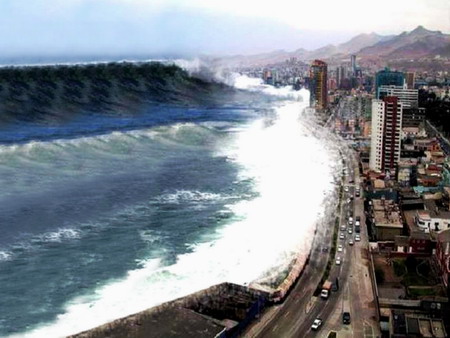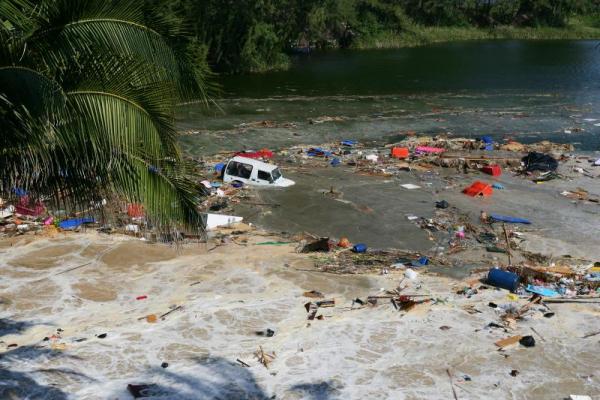El maremoto fue tan grande que hasta los muertos sacó de sus tumbas
(“The tsunami was so big that it even took the dead from their graves”).
-- survivor from May 22, 1960 Chilean Tsunami
"What the earthquake didn't take, the sea took away.
And what the sea didn't take, the looters did."
-- survivor from March 1, 2010 Chilean Tsunami
Prior to Boxing Day, 2004, the word "tsunami" was relatively unknown to the majority of
people across the world. The images that followed on the media embossed the word, both
its meaning and devastating consequences, in the mind of all who witnessed them. Now,
the word "tsunami" is understood by most to be one of the most significant causes of
natural disaster known to humankind.
The term is derived from the Japanese language, “tsu” meaning ‘harbour’ and “nami” meaning ‘wave’. As Japan is an island, much of its citizens rely on occupations associated with the ocean and reside close to its shores. This historical dependency on the sea has allowed the Japanese to both respect and fear its power and has imparted an intimate understanding of the meaning of the word tsunami, which were often noticed in the harbors after seismic activity.
The causes of tsunamis are varied but the mechanics of its generation are uniform.
Tsunamis are initiated by a massive displacement of water which generates a wave train,
or series of waves, that vertically displace the overlying water column. As the water
returns to a state of gravitational equilibrium, after the disturbance, waves are generated
that radiate outwards from the foci of disturbance. This disturbance may be the result of
tectonic activity, underwater landslides of continental shelves, volcanic eruption (both
terrestrial and submarine), explosions, or the impact of cosmic bodies such as meteorites.
The impacts of tsunamis, both in the immediate and long term, can be catastrophic on
coastal and neighboring communities. Besides the immediate loss of life and property
following a tsunami, there is extensive concerns to be raised regarding the contamination
of local water sources from debris and those killed in the tsunamis wake. Disease
epidemics may follow due to the masses of decaying organic matter left scattered about.
This eventuality may be exacerbated by the entire destruction of local infrastructure and
the lack of resources required to mitigate the situation. Local agriculture, livestock and
food stores may be completely devastated by the event and food shortages may also
occur. In addition, there is also the psychological impact of the event on the survivors
who may have experienced significant losses and may require long term counseling for
the management of post-traumatic stress and depression.
The most catastrophic event of the past century occurred on Boxing Day of 2004. On
the morning of December 26, 2004 an earthquake measuring 9.3 on the Richter scale
struck off the Northwest coast of the Indonesian island of Sumatra. The earthquake was
caused by the subduction of the Indian Plate which suddenly slid beneath the Sunda
Plate of Eurasia. The tsunami which ensued was estimated to have had run-up waves as
high as 30m (100 ft) along the adjacent coastline and killed more than 240,000 people
in the immediate vicinity. From the epicenter of the earthquake, the tsunami radiated
outward and within 2 hours had claimed 58,000 lives in Thailand, Sri Lanka, and India.
The tsunami wave itself traveled around the entire planet, sea level fluctuations of more
than one foot being measured in both California and New Jersey.
The largest earthquake ever recorded in the 20th century occurred on May 22, 1960 off
the coast of Southern Chile. It measured 9.5 on the Richter scale and created a tsunami
that was experienced across the entire Pacific Ocean. Huge tsunami waves of up to 25m
arrived 10-15 minutes after the earthquake, killing hundreds of people, sinking all the
local fishing boats, and inundating half a kilometer inland. The resulting loss of life was
not nearly that of the Sumatran tsunami, but approximately 2 million people were left
homeless by the event. Lives lost resulted from the tsunami itself as well as landslides
and buildings which collapsed during the event and due to the aftershocks which
followed. Lives were also lost in both Hawaii and Japan from the tsunami itself which
traveled across the entire Pacific Ocean.
Tsunamis are one the highest risk causes of natural disaster causing both extensive
devastation locally and, due to their ability to travel vast distances, destruction in many
distant communities as well. More cognizant of the great danger associated with these
phenomenon, preparatory measures have been instituted in many coastal areas to warn
local residents of imminent tsunamis. Unfortunately, these warning systems rely
primarily upon the empirical data collected by seismographic instruments and do not take
into account all the possibilities of tsunami genesis. As the majority of humanity tends to
reside on or in close proximity to coastal areas, more effort should be spent further
developing these warning systems to encompass events that may generate tsunamis
without the measurable tectonic activity currently necessary to alarm those monitoring
the likelihood of these emergency situations arising.

